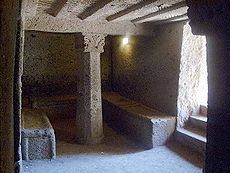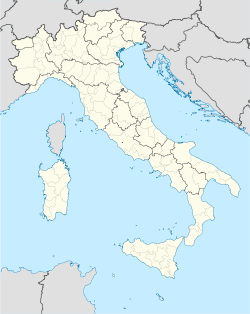- Cerveteri
-
Cerveteri — Comune — Comune di Cerveteri 
Coat of armsLocation of Cerveteri in Italy Coordinates: 42°00′N 12°06′E / 42°N 12.1°E Country Italy Region Lazio Province Rome Frazioni Sasso, Ceri, Valcanneto, Marina di Cerveteri, Cerenova, Campo di mare, San Martino, I Terzi, Due Casette Government - Mayor Gino Ciogli Area - Total 134.43 km2 (51.9 sq mi) Elevation 81 m (266 ft) Population (30 April 2009) - Total 35,517 - Density 264.2/km2 (684.3/sq mi) Demonym Cerveterani Time zone CET (UTC+1) - Summer (DST) CEST (UTC+2) Postal code 00052 Dialing code 06 Patron saint St. Michael Archangel Saint day May 8 Website Official website Etruscan Necropolises of Cerveteri and Tarquinia * UNESCO World Heritage Site
Country Italy Type Cultural Criteria i, iii, iv Reference 1158 Region ** Europe and North America Inscription history Inscription 2004 (28th Session) * Name as inscribed on World Heritage List
** Region as classified by UNESCOCerveteri [ʧer'vɛ:teri] is a town and comune of the northern Lazio, in the province of Rome. Originally known as Caere (also Caisra and Cisra), it is famous for a number of Etruscan necropolis that include some of the best Etruscan tombs anywhere.
Contents
Main sights
Necropolis of the Banditaccia
The most famous attraction of Cerveteri is the Necropoli della Banditaccia, which has been declared by UNESCO a World Heritage Site together with the necropoleis in Tarquinia. It covers an area of 400 ha, of which 10 ha can be visited, encompassing a total of 1,000 tombs often housed in characteristic mounds. It is the largest ancient necropolis in the Mediterranean area. The name Banditaccia comes from the leasing (bando) of areas of land to the Cerveteri population by the local landowners.
The tombs date from the 9th century BC (Villanovan culture) to the late Etruscan age (3rd century BC). The most ancient ones are in the shape of a pit, in which the ashes of the dead were housed; also simple potholes are present.
From the Etruscan period are two types of tombs: the mounds and the so-called "dice", the latter being simple square tombs built in long rows along "roads". The visitable area contains two such "roads", the Via dei Monti Ceriti and the Via dei Monti della Tolfa (6th century BC).
The mounds are circular structures built in tuff, and the interiors, carved from the living rock, house a reconstruction of the house of the dead, including a corridor (dromos), a central hall and several rooms. Modern knowledge of Etruscan daily life is largely dependent on the numerous decorative details and finds from such tombs. The most famous of these mounds is the so-called Tomba dei Rilievi (Tomb of the Reliefs, 3rd century BC), identified from an inscription as belonging to one Matunas and provided with an exceptional series of frescoes, bas-reliefs and sculptures portraying a large series of contemporary life tools.
The most recent tombs date from the 3rd century BC. Some of them are marked by external cippi, which are cylindrical for men, and in the shape of a small house for women.
A large number of finds excavated at Cerveteri are in the National Etruscan Museum, Rome, with others in the Vatican Museums and many other museums around the world. Others, mainly pottery, are in the Archaeological Museum at Cerveteri itself.
Others
- The Rocca (castle)
- Church of Santa Maria Maggiore, including a medieval section reachable from the 1950s addition through a triumphal arch.
- Palazzo Ruspoli, rebuilt as baronal palace by the Orsini in 1533. The portico and the loggia on the façade are from the 17th century. It is connected to Santa Maria Maggiore through a passetto (enclosed bridge), built in 1760.
- The small church of Sant'Antonio Abate, with a 1472 fresco by Lorenzo da Viterbo.
- The medieval burgh of Ceri
- Castle of Cerenova
Cerveteri DOC
Around the city of Cerveteri is an Italian DOC wine region that produces red and white blended wines. The red wines are blends of 60% Sangiovese and Montepulciano, 25% Cesanese and up to 30% of Canaiolo, Carignan and Barbera. The grapes are limited to a harvest yield of 15 tonnes/ha and the final wine must have a minimum alcohol level of 11%. The white wines are composed of a minimum blend of 50% Trebbiano, Romagnolo and Giallo, a maximum of 35% Malvasia di Candia and a maximum of 15% Friulano, Verdicchio, Bellone and Bombino Bianco. The grapes are limited to a harvest yield of 14 tonnes/ha and the final wine must have a minimum alcohol level of 12%.[1]
Twin cities
See also
References
- ^ P. Saunders Wine Label Language pg 137 Firefly Books 2004 ISBN 1552977200
Lazio · Comuni of the Province of Rome Affile · Agosta · Albano Laziale · Allumiere · Anguillara Sabazia · Anticoli Corrado · Anzio · Arcinazzo Romano · Ardea · Ariccia · Arsoli · Artena · Bellegra · Bracciano · Camerata Nuova · Campagnano di Roma · Canale Monterano · Canterano · Capena · Capranica Prenestina · Carpineto Romano · Casape · Castel Gandolfo · Castel Madama · Castel San Pietro Romano · Castelnuovo di Porto · Cave · Cerreto Laziale · Cervara di Roma · Cerveteri · Ciampino · Ciciliano · Cineto Romano · Civitavecchia · Civitella San Paolo · Colleferro · Colonna · Fiano Romano · Filacciano · Fiumicino · Fonte Nuova · Formello · Frascati · Gallicano nel Lazio · Gavignano · Genazzano · Genzano di Roma · Gerano · Gorga · Grottaferrata · Guidonia Montecelio · Jenne · Labico · Ladispoli · Lanuvio · Lariano · Licenza · Magliano Romano · Mandela · Manziana · Marano Equo · Marcellina · Marino · Mazzano Romano · Mentana · Monte Compatri · Monte Porzio Catone · Monteflavio · Montelanico · Montelibretti · Monterotondo · Montorio Romano · Moricone · Morlupo · Nazzano · Nemi · Nerola · Nettuno · Olevano Romano · Palestrina · Palombara Sabina · Percile · Pisoniano · Poli · Pomezia · Ponzano Romano · Riano · Rignano Flaminio · Riofreddo · Rocca Canterano · Rocca Priora · Rocca Santo Stefano · Rocca di Cave · Rocca di Papa · Roccagiovine · Roiate · Rome · Roviano · Sacrofano · Sambuci · San Cesareo · San Gregorio da Sassola · San Polo dei Cavalieri · San Vito Romano · Sant'Angelo Romano · Sant'Oreste · Santa Marinella · Saracinesco · Segni · Subiaco · Tivoli · Tolfa · Torrita Tiberina · Trevignano Romano · Vallepietra · Vallinfreda · Valmontone · Velletri · Vicovaro · Vivaro Romano · ZagaroloCategories:- Cities and towns in Lazio
- Communes of the Province of Rome
- World Heritage Sites in Italy
Wikimedia Foundation. 2010.









